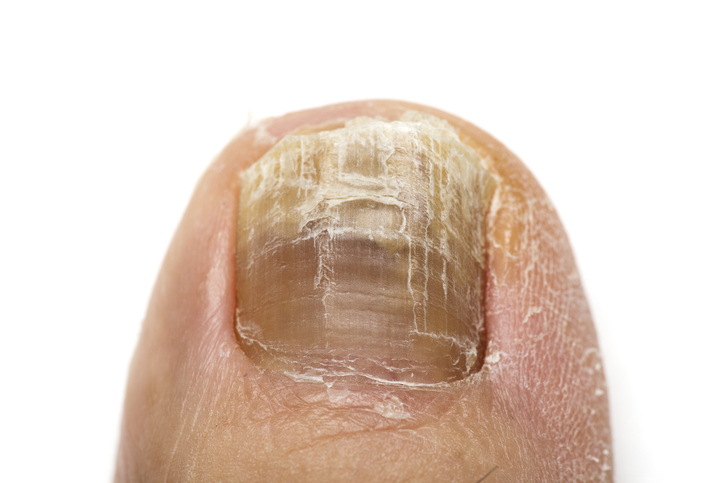Toenail Fungus Treatment
Fungal infections are very common on both fingernail and toenails.
What is Toe Nail Fungus?
Toenail fungus often begins as an infection in the skin called tinea pedis (also known as athlete’s foot). The fungus often starts under the nail fold at the end of the nail. Over time it grows underneath the nail and causes changes to its appearance, such as a yellow or brownish discoloration. It can also cause thickening and deformity of the toenail. Many people have difficulty with their toenails and need assistance in caring for them. A foot and ankle surgeon can diagnose the cause of toenail problems and recommend treatments.
Don't Worry! Fingernail and Toenail Fungus is More Common Than You Think!
Fungal infections are very common on both fingernail and toenails. It is a living organism that thrives in dark, damp environments such as under and around nails. Toes are more likely to be affected by fungus since it is attracted to a dark and damp environment which is more common on the foot than on the hand. Fungus of the toenails can affect people of all ages, although it most commonly affects individuals who are older. In more severe conditions, affected nails can have a yellowish or brownish discoloration. They may thicken or become brittle over time, and may even shed. Sometimes the nails have crumbling edges. It can be embarrassing, unsightly, disfiguring, and at times, painful.
How to Treat Toenail & Fingernail Fungus
If you have a fungal nail infection that causes quality-of-life problems, such as discomfort, pain, or embarrassment, you should contact us today.

When to Seek Treatment Options for Toenail Fungus
Treatment for a fungal nail infection includes using medicines, taking steps to prevent the infection from returning and possibly removing the affected nail. Treatment is generally successful, but treatment does not work for 20% to 25% of people with the condition. You may decide not to treat a fungal nail infection if your nail is discolored or damaged but not painful. Antifungal medicine does not guarantee a cure, and antifungal pills (oral medicine) could have their side effects. Without treatment, fungal nail infections tend to get worse, infecting more of the nail or surrounding skin. Early treatment may shorten treatment time and increase your chances of being cured.
Treatment Option 1:
Oral Medication
Antifungal pills (oral medicine) offer the best chance of a cure. But they require close monitoring with labwork and are generally reserved for moderate-to-severe or difficult-to-treat fungal nail infections. Pills include terbinafine (Lamisil), itraconazole (Sporanox), and fluconazole (Diflucan).
Treatment Option 2:
Topical Medicine
Antifungal topical medicine (liquid and lacquers) are applied to the infected nails and surrounding areas of the skin. They may be used for mild-to-moderate infections and to help prevent an infection from returning or to prevent athlete’s foot from spreading to the nails. Topical medicines may not be as effective as oral medicines. They require a compliance of daily application for many months, up to a year to see result. And they can also be used in conjunction with the oral medication for better effectiveness.
Treatment Option 3:
Nail Removal
Removal of an infected nail is used for severe or recurring fungal nail infections. In the surgical nail removal, the infected nail and tissue is usually removed permanently to prevent the recurrence of the fungus and maintenance of the painful nail deformity.
Your Podiatrist is Your Partner in Treating Your Toenail Fungus
Even after apparently successful treatment with antifungal pills, a fungal nail infection can return, either as a new infection or as regrowth of the original fungi. Severe toenail infections, particularly those involving a big toes, are difficult to treat and tend to recur. If you have a mild fungal infection or are concerned about the risks of oral antifungal medicine, consider using a topical treatment. At our office, we have Formula 3 topical medication for sale which has shown great results! We're here to help you cure your toenail fungus for good.
What You Need to Know About Recurring Infections & Prevention Options
Fungal nail infections can be treated successfully, but some types are more easily treated than others. One type, distal subungual onychomycosis, can be a lifelong infection and hard to treat. Another type, white superficial onychomycosis, can be easily treated.
Even after treatment, your nails may continue to look irregular in shape and appearance. It can take a year or longer before they return to normal. Good foot hygiene and practices also help to prevent the infection from returning.
3 Convenient Locations
Reisterstown
Address:
4 Glyndon Drive, Suite 2A
Reisterstown, MD 21136
Towson
Address:
7600 Osler Drive, Suite 105
Towson, MD 21204
Baltimore- Rotunda
Address:
711 W. 40th Street, Suite 351
Baltimore, 21211
Contact the Family Podiatry of Maryland Team
Interested in booking at one of our three convenient locations? Feel free to send us a message so we can reach out to you as soon as possible! We're here to help with all your foot and ankle needs.
